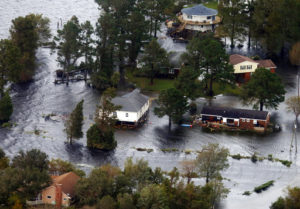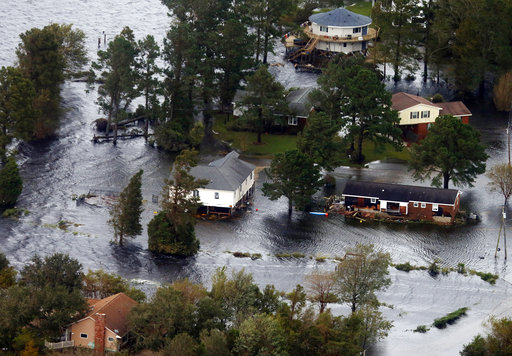Monday, Sept. 17, 2018, 9:55 am — Record-setting, still-rising floods covering much of eastern North Carolina are preventing companies, regulators and environmental groups from making a comprehensive assessment of damage from Hurricane Florence.
On Monday, bucketing rains and tornado warnings continued to bedevil both Carolinas as the storm moves northeast, while many rivers are still days from cresting. North Carolina will be dealing with flooding for at least two weeks, said Wylie Quillian, a National Weather Service hydrologist.
At least 17 people were killed in the storm, according to Associated Press, and almost a half-million homes and businesses are without power. Florence’s remnants were about 125 miles (200 kilometers) west-southwest of Roanoke, Virginia, at 5 a.m. Monday, according to the National Weather Service.
The coastal city of Wilmington was cut off by the disaster — officials are planning to bring in hospital and other emergency personnel by air — and hundreds of search-and-rescue boats cruised inundated streets in the state’s sodden east Sunday. About 496,037 homes and businesses from Virginia to South Carolina were without electricity early Monday as a result of the storm, according to utility websites.
Questions Abound
Officials don’t yet know the full effect of the hurricane on the region’s massive industrial agriculture complexes, or how long it will take to restore power. They don’t know the extent of any environmental damage from a Duke Energy Corp. coal-ash spill and a wastewater discharge in Wilmington. Nor is it clear whether efforts to drain waste-processing facilities for North Carolina’s hog farms succeeded before rainfall that reached 40 inches in places.
“There’s a lot of damage in the hardest hit areas,” David Fountain, Duke Energy Corp.’s North Carolina president, said in an interview with Bloomberg Television. “It’s really going to take a while for the floodwaters to recede so that we can get in and conduct our damage assessment.”
The North Carolina Department of Transportation advised motorists not to travel through the state because several stretches of Interstate 95 and Interstate 40 are flooded.
The storm also affected rails. Nine locomotives and five rail cars derailed from a CSX Corp. train near Lilesville about 6 p.m. Sunday. The two-person crew operating the 125-car train was treated for minor injuries, and diesel fuel and motor oil leaked from the locomotives, CSX said. The cause is being investigated.

North Carolina had more than 1,000 search-and-rescue personnel out and more than 2,000 boats and 36 helicopters were either deployed or available to help stranded residents, Michael Sprayberry, the state’s director of emergency management, said Sunday on ABC’s “This Week.”
South Carolina Governor Henry McMaster said the death toll could rise alongside the “angry waters.”
The dead range in age from 7 months to 81 years. Five were killed when their vehicles lost control on flooded roads, a mother and her baby died when a tree fell on their Wilmington home and a couple perished from carbon-monoxide poisoning after using a generator inside their coastal South Carolina home as the storm lashed the region.
The storm, now a tropical depression, is expected to accelerate Tuesday. Parts of the Mid-Atlantic as far north as southern New York and New England are set to receive additional rainfall, and a few tornadoes are possible in the region stretching from northeastern South Carolina to southern Pennsylvania on Monday.
Rainfall totals for southeast North Carolina will probably be close to 40 inches (102 centimeters) and 20 inches elsewhere in the region. More than 30 rivers in North Carolina have flooded and at least 15 are at “major flooding” level, according to the Flood Inundation Mapping and Alert Network website.
Florence is expected to cause about $22 billion in economic losses based on new model estimates, said Chuck Watson, a disaster modeler for Enki Research in Savannah, Georgia. Typically, a storm Florence’s size would cause about $12 billion in losses.
“Florence is still trying to crack the top 10 U.S. storms, and with all the post-storm flooding might well make it,” Watson said.
Flooded Farms
The state’s 4,000 hog lagoons are holding out, even though huge swaths of farmland in the state’s eastern corner are under water, Governor Roy Cooper said. The lined earthen pits that hold waste had been a major environmental concern as the flood waters rose.
“We are closely monitoring hog lagoons, and we haven’t had any reports of issues,” Cooper said in a briefing Sunday.
However, some experts cast doubt. The counties most severely affected are major farming areas, with some barely above sea level, said Professor Mark Sobsey of the environmental sciences department at the University of North Carolina at Chapel Hill.
The North Carolina Department of Environmental Quality plans to try early this week to inspect the damaged Duke Energy landfill in Wilmington near the Cape Fear River, spokeswoman Megan Thorpe said. A breach spilled about 2,000 cubic yards of coal ash — enough to fill about two-thirds of an Olympic-sized pool — which can carry arsenic, mercury, lead and selenium.
Duke’s Fountain said the company is confident most material was contained and “in the safety of the public and the environment.”
The U.S. Environmental Protection Agency has received “unverified reports” of wastewater releases from sewer-main breaches and other systems, but can’t conduct its own assessment yet, the agency said Sunday. In Wilmington, an estimated 5.25 million gallons of partially treated wastewater spilled into the Cape Fear from a treatment plant when two generators failed Friday.
Still Rising
Waterkeeper Alliance, an environmental watchdog group, hopes to conduct an aerial survey to assess waterways for toxic spills from lagoons. More than 60 swine operations house more than 235,000 hogs that generate almost 202 million gallons of waste per year within the coastal floodplain, according to the group.
South Carolina is waiting for the deluge to drift downstream from its northern neighbor. The water “is coming our way,” McMaster said in a briefing Sunday.
“The question is, how high will the water be, and we just do not know,” he said.
Topics Flood Agribusiness North Carolina Pollution South Carolina
Was this article valuable?
Here are more articles you may enjoy.



 Grandson Not Covered Under Grandma’s Home Insurance
Grandson Not Covered Under Grandma’s Home Insurance  Thumbs Down on SELF DRIVE Act as Written, Says Industry Trades
Thumbs Down on SELF DRIVE Act as Written, Says Industry Trades  SIAA Announces Strategic Partnership With Progressive
SIAA Announces Strategic Partnership With Progressive  Warburg Mulls $1 Billion Sale of London Insurance Broker McGill
Warburg Mulls $1 Billion Sale of London Insurance Broker McGill 

